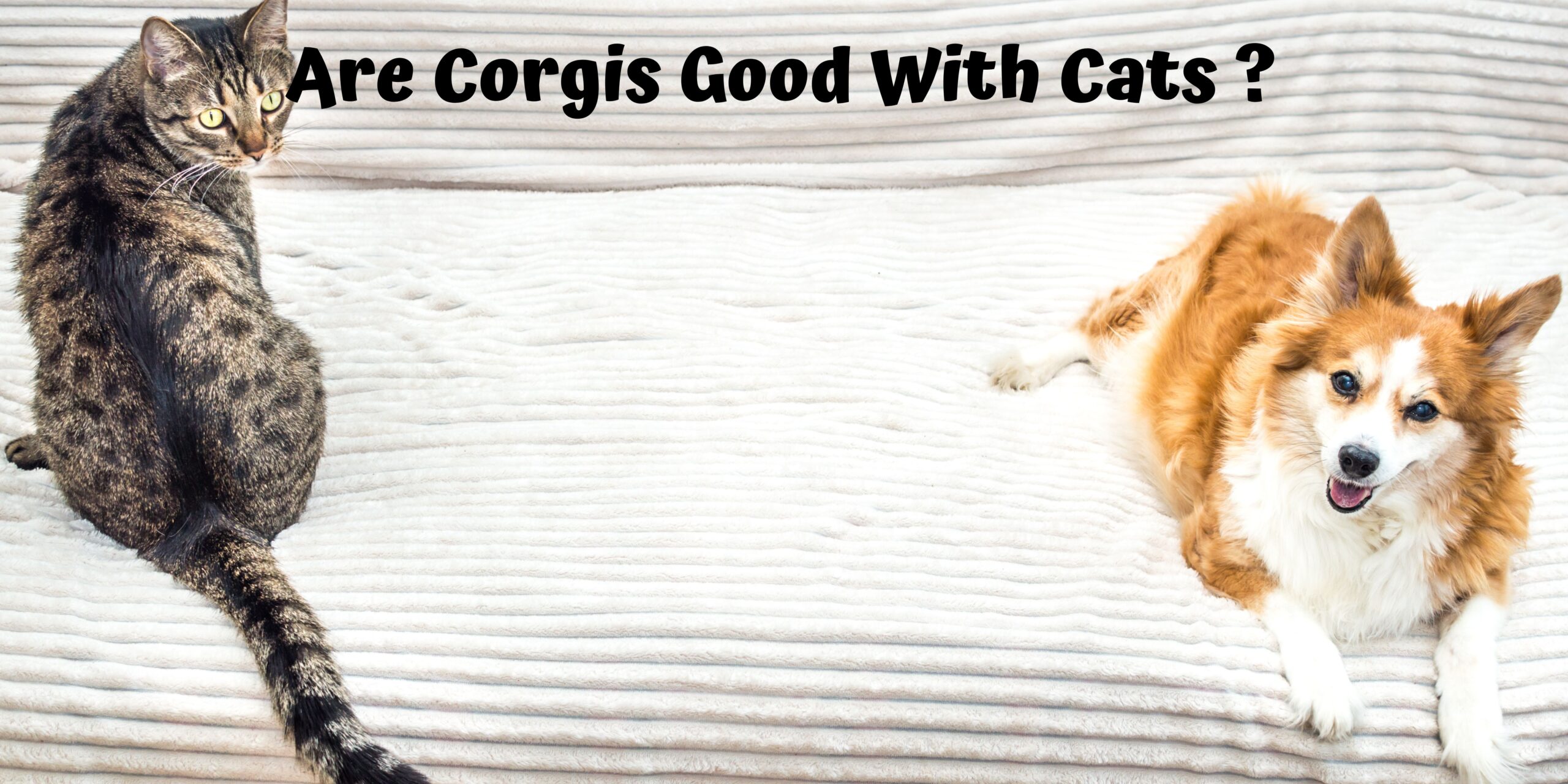Welsh Corgis, which include the Pembroke and Cardigan breeds, are known for their distinctive tiny legs and herding dog heritage.
These active dogs, adored by many, including Queen Elizabeth II, often exhibit a strong instinct to herd smaller animals.
This natural tendency necessitates understanding their behavior, especially when introducing them as a new family member to a home with cats.
Are Corgis Good With Cats?
Understanding Early Socialization
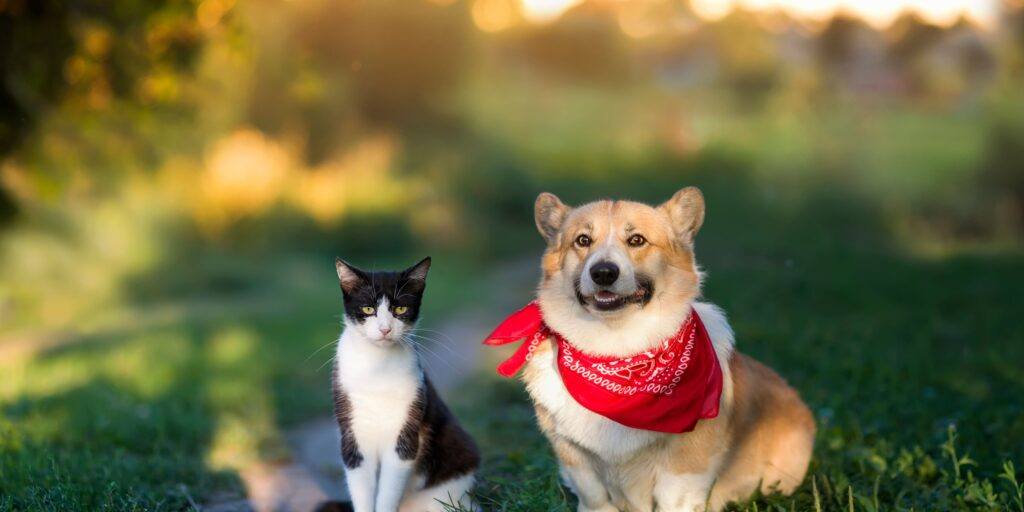
Early socialization is the best way to ensure that your corgi puppy or older corgi develops good relationships with other species, such as cats.
Introducing them at a young age is beneficial, as it helps them adapt to different personalities and species. The first step is to create a safe space for the corgi and the feline friend, whether introducing a young puppy or an adult corgi.
- What is Early Socialization?
- Early socialization involves exposing a young puppy or older dog to various experiences, including environments, people, animals, and noises.
- The critical period for socialization in dogs is typically between 3 and 14 weeks of age, though older dogs can also benefit from structured socialization experiences.
- Importance for Corgis
- Corgis are intelligent and alert dogs with a strong herding instinct. These traits make them wonderful companions but can lead to behaviors like chasing or nipping if not properly socialized.
- Well-socialized Corgis are more likely to be confident, calm, and well-behaved in various situations.
Socializing Corgis with Cats
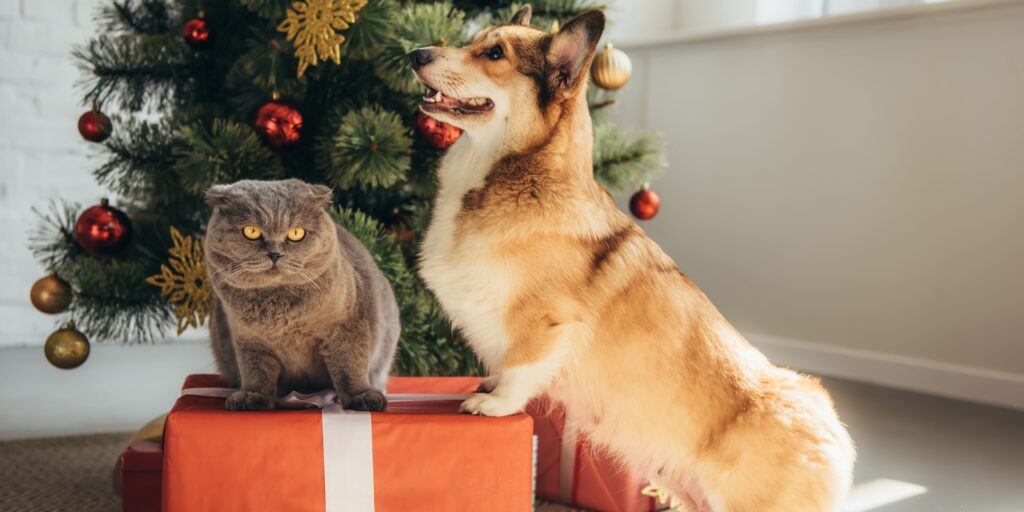
- Starting Young
- Introducing a Corgi puppy to a cat during its critical socialization period can be more effective, as puppies are generally more adaptable and less set in their ways.
- Puppies are naturally more curious and less fearful, which can facilitate positive interactions with cats.
- Introducing Adult Corgis
- While more challenging, adult Corgis can also learn to coexist peacefully with cats.
- It requires patience and may take longer, as adult dogs have more established behaviors and reactions.
Related: Cinnamon Siamese Cat: Exploring These Beautiful Felines
Steps for Introduction
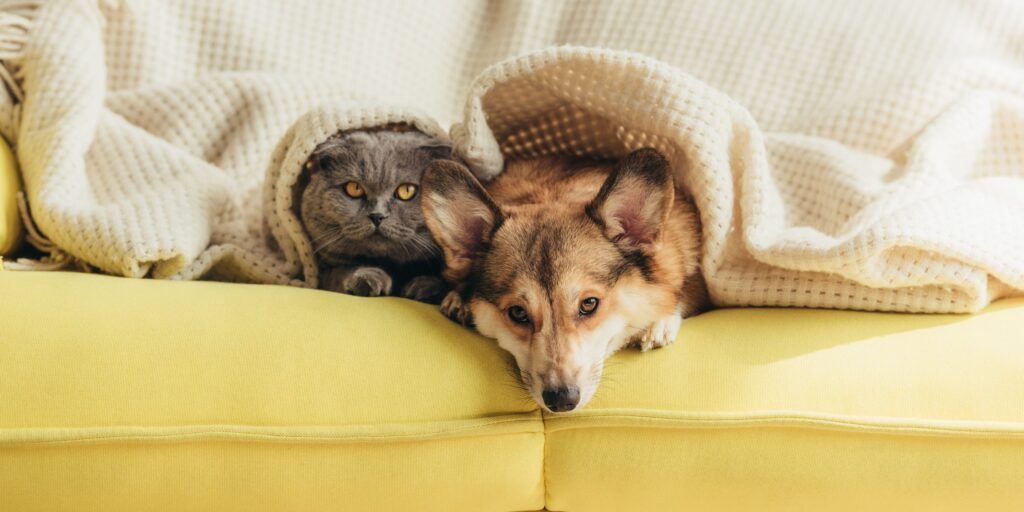
- Creating a Safe Space
- Ensure the Corgi and the cat have safe spaces to retreat if they feel overwhelmed or scared.
- Use baby gates or barriers to allow them to see and smell each other without direct contact initially.
- Controlled Meetings
- Begin with short, controlled meetings. Keep the Corgi on a leash and allow the cat to approach on their terms.
- Watch for signs of stress or aggression from either animal and separate them if necessary.
- Positive Reinforcement
- Use treats and praise to encourage calm and non-aggressive behavior from the Corgi.
- Gradually increase the duration and freedom of their interactions as they become more comfortable with each other.
- Supervision
- Always supervise interactions until you are confident that they can coexist peacefully.
- Never force interaction. Let them progress at their own pace.
- Early socialization ensures a harmonious relationship between a Corgi and a cat. It helps adapt to different personalities and species, reducing the likelihood of behavioral issues.
- Consistency, patience, and positive reinforcement are crucial throughout the process.
- Remember, each animal is unique, and the pace of socialization will vary. The goal is to build mutual respect and understanding between the Corgi and the cat.
Related: Manx Maine Coon Mix Cat: A Stubby Tailed Feline Breed
Understanding Corgi Body Language
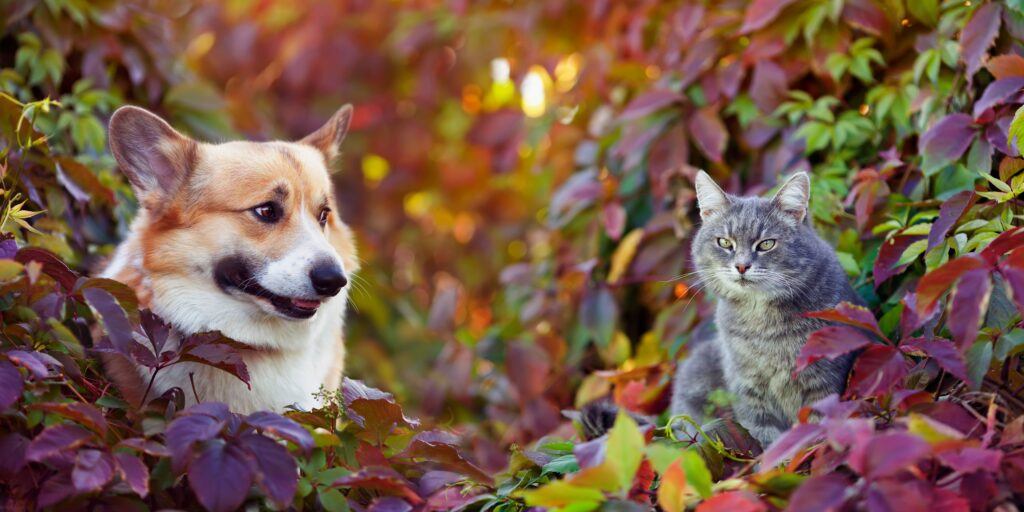
Observing the body language of your corgi and the cat is crucial to identify any signs of aggression. Corgis are friendly dogs that often display a willingness to engage.
However, their herding instincts can sometimes be misinterpreted as aggressive behavior by cats, especially older cats or those with different personalities.
Positive reinforcement training can help manage Corgi’s behavior.
- Friendly Gestures
- Tail wagging, relaxed body posture, and a playful bow (front end down, back end up) usually indicate a friendly and playful attitude.
- A Corgi may approach slowly with a lowered body to show submission or a desire to engage without threatening.
- Signs of Herding Instinct
- Corgis may display circling, nipping at heels, or trying to lead or chase the cat, which is part of their herding behavior.
- While not aggressive, these behaviors can intimidate or annoy a cat.
- Aggressive Indicators
- Growling, baring teeth, stiff body posture, and a raised hackle (the hair along the spine) can signal aggression or discomfort.
- A direct, fixed stare can also signify a challenge or aggression.
Related: Manx Maine Coon Mix Cat: A Stubby Tailed Feline Breed
Understanding Cat Body Language
- Friendly Signs
- A relaxed posture, purring, slow blinking, and approaching with a raised tail usually indicate a friendly or curious cat.
- Rubbing against objects or people and kneading are signs of comfort and affection.
- Signs of Fear or Discomfort
- Hissing, arching the back, flattening the ears, and puffing up the fur are clear signs of fear or aggression.
- A tucked tail and avoidance behavior (like retreating or hiding) indicate fear or discomfort.
- Aggressive Behavior
- Swatting, loud growling or yowling, and an unblinking, focused stare indicate a readiness to defend or attack.
Related: http://Maine Coon Mix Characteristics
Managing Interactions
- Observation
- Pay close attention to these body language cues during interactions. Recognizing early signs of discomfort or aggression allows you to intervene before a situation escalates.
- Intervention and Training
- If signs of aggression or herding behavior are observed in the Corgi, intervene calmly and redirect their attention.
- Positive reinforcement training, like rewarding calm or non-herding behaviors, can help in managing the Corgi’s instincts.
- Creating Positive Associations
- Encourage positive interactions by associating the presence of the other animal with good things (like treats or playtime).
- Gradually, they can learn to associate each other’s presence with positive outcomes, reducing aggression or fear.
- Professional Help
- If aggressive behaviors persist or you’re unsure how to manage them, consulting a professional animal behaviorist can be beneficial.
- Understanding the body language of both animals is crucial for a harmonious relationship. It allows you to respond appropriately to their needs and emotions.
- Early intervention and consistent training can help manage natural instincts and behaviors, promoting a peaceful coexistence.
- Remember, every animal is different. Adapting to their personalities and needs requires patience and continuous observation.
Principles of Proper Introductions
Proper introductions are vital. Allow the corgi and cat to observe each other from a distance initially, providing escape routes if the interaction becomes overwhelming.
This step is especially crucial for stray cats or smaller animals, who may not be used to living in a multi-pet household.
- Gradual Exposure
- Start by allowing the Corgi and the cat to become aware of each other’s presence without direct interaction. This can be done through scent swapping or keeping them in adjacent rooms where they can hear and smell each other.
- Visual Introduction
- Allow them to observe each other safely through a baby gate or a cracked door. This step is essential for gauging their reactions to each other without physical contact.
- Neutral Territory
- When they’re ready for face-to-face interaction, choose a neutral space where neither animal feels territorial. This reduces the likelihood of defensive aggression.
Specific Considerations
- For Stray or Formerly Stray Cats
- Stray cats or cats not used to living in a household may be more skittish or fearful. These cats need extra time and patience during introductions.
- Ensure that they have a safe, enclosed space to retreat and observe the Corgi from a distance.
- For Smaller Animals or Puppies
- Small animals and puppies can be more vulnerable or playful, which requires careful monitoring to ensure that play does not escalate into something more aggressive or harmful.
Creating Safe Escape Routes
When bringing in a new cat or a new dog, it’s essential to establish separate room environments initially. This allows the corgi and the cat to have their own space, reducing the potential for aggressive behavior.
For the first meeting, having a baby gate or a similar barrier ensures both animals feel secure. Watchful eyes on their body language can provide insights into their comfort levels.
- Importance of Escape Routes
- The corgi and the cat should have clear escape routes during their initial meetings. This allows them to retreat if they feel threatened or overwhelmed.
- For cats, provide high perches or cat trees where they can observe the Corgi from a safe height.
- Controlled Environment
- Ensure the environment is controlled and escape-proof to prevent chasing or accidental injury.
Monitoring and Managing Interactions
- Observation
- Closely observe their body language and behaviors during the initial meetings. Look for signs of fear, aggression, or discomfort.
- Interrupt and separate them if necessary and try again later, gradually increasing the duration of their interactions.
- Positive Reinforcement
- Reward both animals for calm and non-aggressive behavior. This helps in building positive associations with each other’s presence.
The Role of Patience
- Introducing a corgi to a cat requires patience and time, especially with a stray or smaller animal.
- Rushing the introduction process can lead to long-term behavioral issues or hatred between the pets.
- Proper introductions are the cornerstone of building a peaceful multi-pet household.
- Each step, from scent swapping to controlled face-to-face interactions, must be handled carefully and patiently.
- The goal is to create a mutually respectful and comfortable environment for the Corgi and the cat, acknowledging and respecting their needs and personalities.
Building a positive relationship between a Corgi and a cat involves creating enjoyable shared experiences and reinforcing good behavior through positive reinforcement. This process is crucial to foster a harmonious living environment, especially with active breeds like Corgis. Here’s an expansion on how to achieve this:
Shared Activities
Building a positive relationship between a Corgi and a cat involves creating enjoyable shared experiences and reinforcing good behavior through positive reinforcement.
This process is crucial to foster a harmonious living environment, especially with active breeds like Corgis. Here’s an expansion on how to achieve this:
- Simultaneous Playtime
- Engage in play activities that cater to the Corgi and the cat, such as using toys that stimulate both species. For example, a toy that the Corgi can chase and a cat can pounce on.
- Ensure the play area is spacious enough to prevent accidental collisions and give each pet space.
- Relaxation Together
- Encourage relaxed coexistence in shared spaces like the living room. This can be facilitated by providing comfortable resting spots for both pets in the same area.
- Over time, this shared relaxation can lead to a more peaceful and accepting relationship.
- Feeding in Proximity
- Feeding them in the same area (but with separate bowls and at a comfortable distance) can also promote positive associations. Ensure that each pet can eat without feeling threatened by the other’s presence.
Positive Reinforcement Training
- For the Corgi
- Use treats, praise, and affection to reinforce calm and non-aggressive behavior around the cat.
- Training commands like ‘sit,’ ‘stay,’ or ‘leave it’ can be especially useful in managing Corgi’s behavior around the cat.
- For the Cat
- Cats also respond to positive reinforcement. Reward the cat for being calm or curious about the Corgi without showing fear or aggression.
- Treats and gentle petting can be effective rewards for cats.
Supervision and Intervention
- Watchful Eye
- Always supervise their interactions, especially in the early stages of their relationship. This ensures you can intervene if play becomes too rough or signs of stress or aggression appear.
- Step-by-Step Approach
- Start with short, supervised sessions and gradually increase their length as the pets become more comfortable with each other.
Understanding Individual Personalities
- Respect Personal Space
- Recognize that each pet has its own personality and comfort level. Some may need more personal space than others.
- It’s important not to force interactions. Let them approach each other in their own time.
Encouraging Mutual Respect
- Mutual respect is key in a multi-pet household. Pets should learn to respect each other’s space, signals, and boundaries.
- This respect is built over time through positive experiences and consistent reinforcement of good behavior.
- Building a positive relationship between a Corgi and a cat gradually involves shared activities, positive reinforcement, and close supervision.
- A harmonious and friendly relationship can be fostered by recognizing and respecting each pet’s needs and personalities and creating a safe and enjoyable environment for both.
Managing the energy levels of a Corgi, particularly in a household with a cat, is a crucial aspect of fostering a harmonious living environment.
Corgis are high-energy dogs that require ample exercise to maintain their health and well-being. Here’s an expanded view on how to effectively manage this:
Understanding Corgi Energy Levels
Managing the energy levels of a Corgi, particularly in a household with a cat, is a crucial aspect of fostering a harmonious living environment.
Corgis are high-energy dogs that require ample exercise to maintain their health and well-being. Here’s an expanded view of how to effectively manage this
- High Energy Breed
- Corgis are active and intelligent dogs, originally bred for herding. This background gives them a natural drive for activity and mental stimulation.
- Regular exercise is not just a physical need but also a mental one for Corgis.
- Impact on Household Dynamics
- A Corgi with pent-up energy can exhibit behaviors like excessive barking, chewing, or even herding attempts toward the cat, which can be stressful for a feline companion, especially if it prefers a calmer environment.
Exercise Regimen for Corgis
- Routine Exercise
- Consistent daily exercise is crucial. This can include walks, runs, or play sessions in a secure outdoor area.
- Interactive games like fetch, tug-of-war, or agility training can provide both physical exercise and mental stimulation.
- Exercise Outside the Home
- Engaging the Corgi in vigorous exercise outside the home can help reduce their overly energetic behavior indoors. This makes the home environment more peaceful for the cat.
- Dog parks or open spaces where the Corgi can run freely are ideal for this purpose.
Balancing Cat Comfort
- Quiet Time for the Cat
- While the Corgi is out exercising, the cat can enjoy a period of calmness and solitude, which is essential for its well-being, especially for older or more sedentary cats.
- Provide the cat comfortable resting areas and engage in quiet play or grooming sessions.
- Respect for Space
- Teach the Corgi to respect the cat’s space. This can be part of their training and socialization process.
- Use barriers or gates if necessary to give the cat safe areas to retreat.
Indoor Activities for Corgis
- Mental Stimulation
- Alongside physical exercise, mental stimulation is essential. Puzzle toys, treat-dispensing toys, or training sessions can keep a Corgi engaged and mentally stimulated.
- This can also help tire them out in a more controlled and less physically demanding way.
- Scheduled Playtime
- Have specific indoor playtimes where the Corgi can engage in moderate activity without disturbing the cat. This helps establish a routine and expectations for the Corgi.
- Managing Corgi’s energy levels through adequate exercise and mental stimulation is vital to a peaceful cohabitation with a cat.
- It’s essential to strike a balance between meeting Corgi’s needs for activity and not overwhelming the cat, especially if the cat is older or enjoys a quieter environment.
- Regular exercise routines, respect for personal spaces, and tailored indoor activities contribute significantly to maintaining a harmonious multi-pet household.
Corgi Health Issues and Breed Specifics
Addressing health issues and understanding breed specifics are crucial to pet care, especially in a multi-pet household with Corgis and cats.
Each breed, including different lines within a breed, can have unique health concerns and behavioral tendencies.
- General Health Concerns in Corgis
- Corgis are prone to specific health issues, including hip dysplasia, degenerative myelopathy, and obesity.
- Regular veterinary check-ups and a proper diet are essential to manage these risks.
- Show-Line vs. Working-Line Corgis
- Show-Line Corgis: Typically bred for conformation to breed standards. They may have a more laid-back temperament and could be more prone to health issues related to physical appearance, like joint problems due to their structure.
- Working-Line Corgis: Bred for herding and working abilities. They usually have higher energy levels and require more physical and mental stimulation. They might be more robust regarding physical health but have intense herding instincts.
- Exercise and Weight Management
- Due to their risk of obesity and joint issues, managing Corgi’s weight through proper diet and exercise is crucial.
- Tailor their exercise needs based on their specific line; working-line Corgis may need more rigorous activities.
Understanding Cat Breeds
- Behavioral Tendencies of Cat Breeds
- Different cat breeds have varying temperaments and activity levels. For instance, Siamese cats are known for being vocal and active, while Persians are typically more laid-back and relaxed.
- Understanding these tendencies can help manage the cat and Corgi interaction.
- Health Concerns in Cats
- Like dogs, different cat breeds have predispositions to specific health issues. For example, Maine Coons are prone to heart issues, while Bengals may have a higher risk of certain hereditary conditions.
- Regular health check-ups and a breed-appropriate diet are essential.
Cohabitation Considerations
- Meeting Individual Needs
- Ensure that both the Corgi and the cat have their health and behavioral needs met. This includes separate feeding areas, exercise routines, and quiet spaces for the cat.
- Observation and Adaptation
- Be observant of any changes in behavior or health in either pet, as these can indicate underlying issues.
- Adapt the living environment and routines to accommodate health concerns or breed-specific needs.
- Professional Advice
- Consulting with veterinarians and breed experts can provide valuable insights into managing the health and well-being of both Corgis and cats.
- Professional advice is essential when dealing with breed-specific issues.
- Understanding and addressing specific health issues, including the differences between show-line and working-line Corgis, is essential for Corgis’s well-being.
- Similarly, knowing the behavioral tendencies and health risks associated with the cat breed in the household can aid in providing appropriate care and managing interactions between the pets.
- Tailoring care and environmental factors to each pet’s needs helps foster a healthy, harmonious multi-pet household.
Harmonizing Personalities and Training: The Journey of a Corgi and with Cats
As a pet owner and a dedicated dog person, you’re embarking on a unique journey with your puppy Corgi, aiming for the best success in creating a harmonious household with your feline companions, be it a young cat or an adult cat.
This story revolves around overcoming the main challenge of pairing cats, known for their individualistic nature and often embodying the alpha cat persona, with herding dogs like Corgis, celebrated for their tiny legs and big hearts.
Balancing Corgi’s Natural Herding Instincts
Your puppy Corgi, with its innate herding instincts, might initially have a more challenging time adjusting to the presence of cats.
This juxtaposition highlights the need for proper training and understanding the proper steps to manage your Corgi’s natural behaviors.
Corgis often form strong attachments to one-owner dogs, which can be leveraged to guide their interactions with cats.
The Power of Similar Personalities
Discovering the similar personalities between your Corgi and the cats can be the good news you need. Finding common ground will be key, whether it’s a playful young cat or a more reserved adult cat.
You’ll observe how each animal, with its unique traits, can contribute to the overall dynamics of the household.
Strategies for a Good Match
You’ll employ various techniques to ensure a good match between your Corgi and the cats. This includes:
- Observing and Utilizing Similarities: Understanding each pet’s personality to foster connections based on shared interests or behaviors.
- Proper Steps in Introduction: Gradual and careful introduction phases to help each pet adjust at their own pace.
- Training and Guidance: Utilizing proper training methods to curb Corgi’s herding behavior, ensuring it understands boundaries with the cats.
Success with a Little Help
Acknowledging that you might need a little help is part of the journey. Seeking advice from trainers experienced with herding dogs and one-owner breeds or consulting with a veterinarian on the best ways to manage multi-pet dynamics becomes crucial.
Conclusion: Are Corgis Good with Cats?
The most essential thing in integrating a new pup with a feline friend is patience and understanding of their individual personalities.
While there’s a good chance they may become best buddies, remember that each animal requires attention to their needs, such as a separate food bowl or litter box.
Your Pembroke Welsh Corgi and cat can develop a strong, positive relationship with proper steps and patience, becoming your home’s best friends.
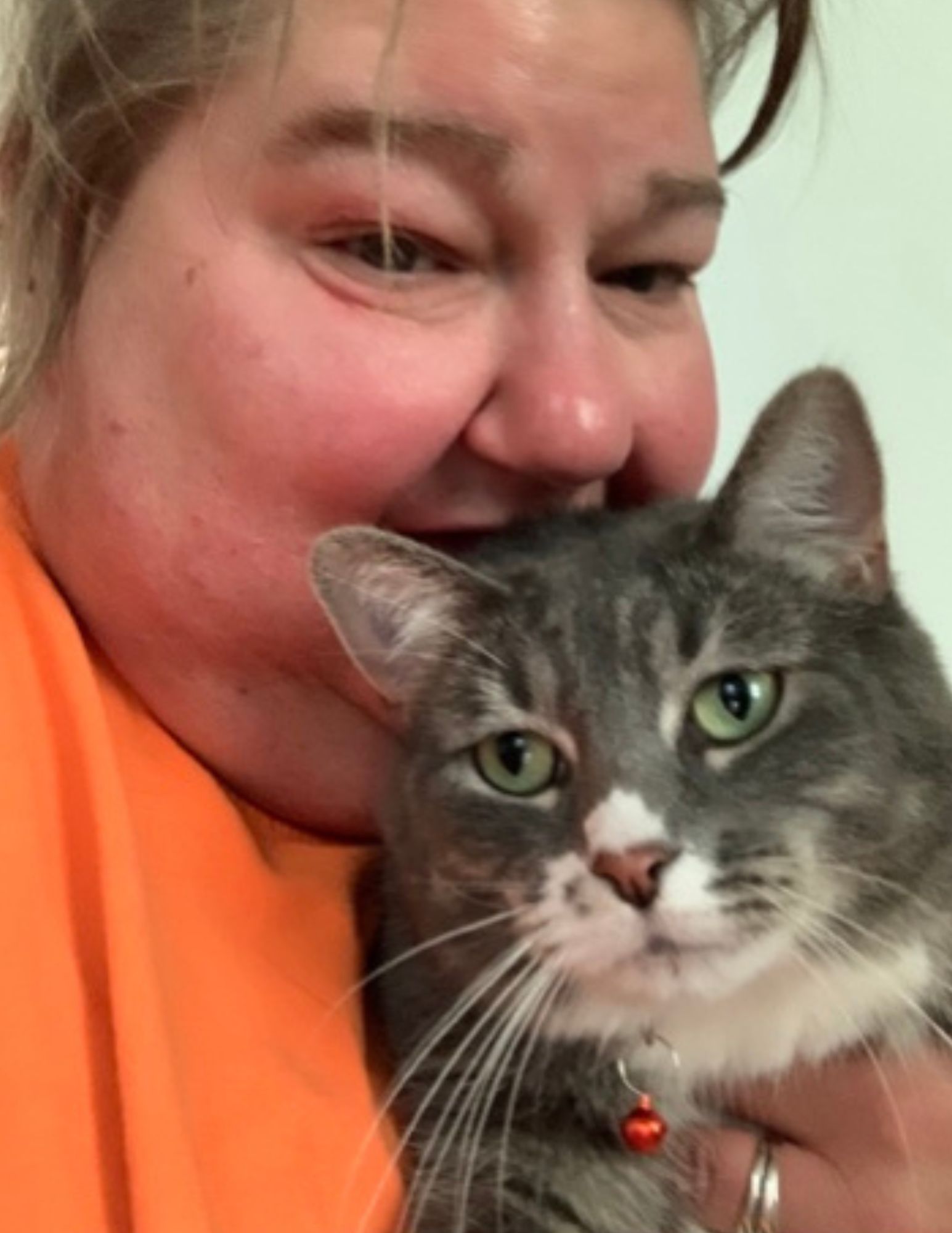
Meet Ann Haasnoot, the passionate founder of CatFurLife.com. A lifelong cat lover from Wisconsin, Ann combines her extensive feline behavior and care knowledge with her love for writing. On her website, she shares invaluable insights about cat breeds, care tips, and her experiences with her beloved furbaby, aiming to deepen the bond between cats and their human companions.

